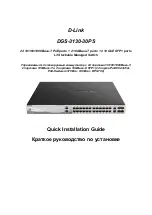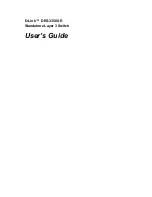
4-6
Troubleshooting
Diagnosing with the LEDs
➏
The network
connection is not
working
properly.
Try the following procedures:
• For the indicated port, verify that both ends of the cabling, at the switch and the
connected device, are connected properly.
• Verify the connected device and switch are both powered
on
and operating correctly.
• Verify you have used the correct cable type for the connection:
– For twisted-pair connections to the fixed 10/100 or 10/100/1000 ports, if the port is
configured to “Auto” (auto negotiate), either straight-through or crossover cables
can be used because of the switch’s “Auto-MDIX” feature and the Auto MDI/MDI-
X feature of the 10/100/1000-T port.
Note:
If the switch port configuration is changed to one of the
fixed configuration
options (for example, 100 Mbps/Full Duplex), then the port operates as
MDI-X only
and you must use the correct type of cable for the connection. In general, for
connecting an end node (MDI port) to the switch, use straight-through cable; for
connecting to MDI-X ports on hubs, other switches, and routers, use crossover
cable.
– For fiber-optic connections, verify the transmit port on the switch is connected to
the receive port on the connected device, and the switch receive port is connected
to the transmit port on the connected device.
• For the dual-personality 10/100/1000-T ports, be sure a mini-GBIC is not installed in the
associated slot.
• For 1000Base-T connections, verify the network cabling complies with the IEEE 802.3ab
standard. The cable should be installed according to the ANSI/TIA/EIA-568-A-5
specifications. Cable testing should comply with the stated limitations for Attenuation,
Near-End Crosstalk, Far-End Crosstalk, Equal-Level Far-End Crosstalk (ELFEXT),
Multiple Disturber ELFEXT, and Return Loss.
The cable verification process must include all patch cables from any end devices,
including the switch, to any patch panels in the cabling path.
• Verify the port has not been disabled through a switch configuration change. You can
use the console interface, or, if you have configured an IP address on the switch, use
the web browser interface to determine the state of the port and re-enable the port if
necessary.
• Verify the switch port configuration matches the configuration of the attached device.
For example, if the switch port is configured as “Auto”, the port on the attached device
also MUST be configured as “Auto”. Depending on the port type, twisted-pair or fiber-
optic, if the configurations don’t match, the results could be a very unreliable
connection, or no link at all.
• If the other procedures don’t resolve the problem, try using a different port or a different
cable.
Tip
Problem
Solution
Summary of Contents for E2620
Page 1: ...Power over Ethernet HP E2620 Switches Installation and Getting Started Guide ...
Page 2: ......
Page 3: ...HP E2620 Switches Installation and Getting Started Guide ...
Page 9: ...vii D Recycle Statements Waste Electrical and Electronic Equipment WEEE Statements D 1 Index ...
Page 10: ...viii ...
Page 78: ......
Page 98: ...C 8 Safety and EMC Regulatory Statements Safety Information China Safety Information China ...
Page 100: ...C 10 Safety and EMC Regulatory Statements EMC Regulatory Statements Korea Taiwan ...
Page 104: ...C 14 Safety and EMC Regulatory Statements EMC Regulatory Statements ...
Page 114: ...6 Index ...
Page 115: ......
















































